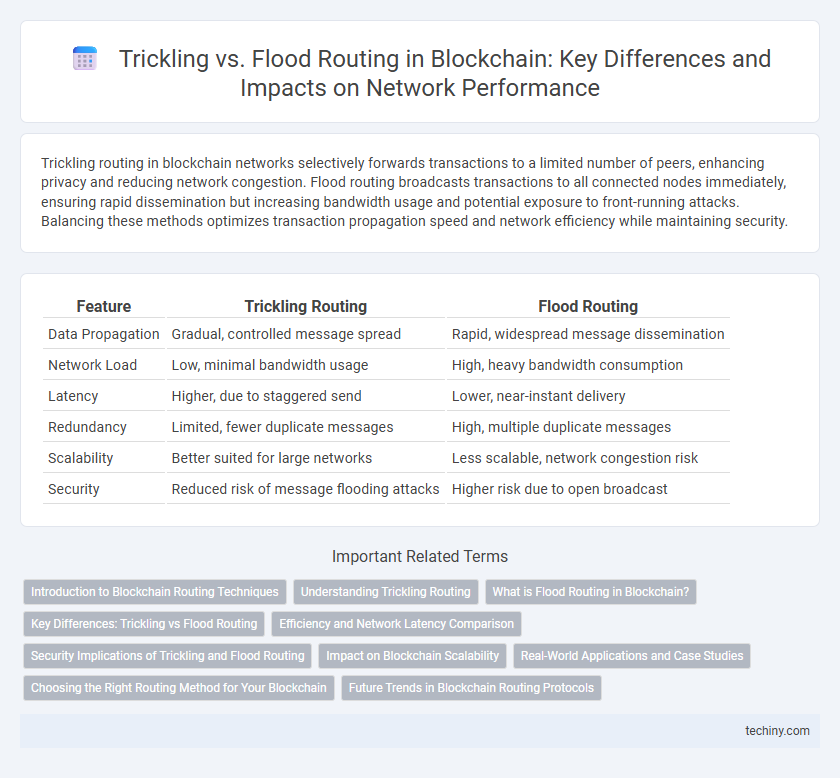Trickling routing in blockchain networks selectively forwards transactions to a limited number of peers, enhancing privacy and reducing network congestion. Flood routing broadcasts transactions to all connected nodes immediately, ensuring rapid dissemination but increasing bandwidth usage and potential exposure to front-running attacks. Balancing these methods optimizes transaction propagation speed and network efficiency while maintaining security.
Table of Comparison
| Feature | Trickling Routing | Flood Routing |
|---|---|---|
| Data Propagation | Gradual, controlled message spread | Rapid, widespread message dissemination |
| Network Load | Low, minimal bandwidth usage | High, heavy bandwidth consumption |
| Latency | Higher, due to staggered send | Lower, near-instant delivery |
| Redundancy | Limited, fewer duplicate messages | High, multiple duplicate messages |
| Scalability | Better suited for large networks | Less scalable, network congestion risk |
| Security | Reduced risk of message flooding attacks | Higher risk due to open broadcast |
Introduction to Blockchain Routing Techniques
Trickling and Flood routing are two fundamental blockchain routing techniques that dictate how transaction data propagates through the network. Trickling involves selectively forwarding transactions to neighboring nodes at randomized intervals, optimizing bandwidth and reducing network congestion. Flood routing rapidly broadcasts transaction data to all connected nodes, ensuring quick dissemination but often leading to increased redundancy and higher bandwidth consumption.
Understanding Trickling Routing
Trickling routing in blockchain networks involves gradually sharing transactions with peers to reduce bandwidth usage and improve privacy by minimizing transaction propagation patterns. Unlike flood routing, which broadcasts data immediately and widely, trickling regulates the flow of information to obscure transaction origins and prevent network congestion. Understanding trickling routing enhances the design of efficient, secure peer-to-peer communication protocols.
What is Flood Routing in Blockchain?
Flood routing in blockchain is a message propagation method where each node broadcasts received transactions or blocks to all its connected peers simultaneously, ensuring rapid dissemination across the network. This technique enhances network resilience and reduces delays in transaction confirmation by minimizing the chance of information loss or bottlenecks. While flood routing increases communication overhead, it improves overall data availability and consistency in decentralized blockchain systems.
Key Differences: Trickling vs Flood Routing
Trickling routing in blockchain propagates transactions by gradually forwarding them to a limited number of peers, optimizing network bandwidth and reducing the risk of spam or network overload. In contrast, flood routing broadcasts transactions to all connected nodes simultaneously, ensuring rapid dissemination but causing higher network congestion and increased resource consumption. The key difference lies in trickling's controlled, bandwidth-efficient propagation versus flood routing's aggressive, high-throughput transaction distribution.
Efficiency and Network Latency Comparison
Trickling routing optimizes bandwidth usage by gradually propagating transactions, reducing network congestion and minimizing redundant data transmission. Flood routing prioritizes speed, broadcasting transactions to all nodes simultaneously, which lowers latency but increases network bandwidth consumption and potential bottlenecks. Efficiency in trickling is higher due to controlled message flow, while flood routing achieves faster propagation at the expense of increased network resource usage.
Security Implications of Trickling and Flood Routing
Trickling routing in blockchain enhances security by limiting the exposure of transaction origins, reducing the risk of deanonymization through network analysis. Flood routing broadcasts transactions to all peers simultaneously, which increases data redundancy but can enable attackers to more easily correlate transaction timing and source, compromising privacy. Implementing trickling reduces attacks like Eclipse by controlling information flow, whereas flood routing prioritizes speed over anonymity, making it less secure against targeted surveillance.
Impact on Blockchain Scalability
Trickling routing reduces network congestion by selectively propagating transactions, enhancing blockchain scalability through more efficient bandwidth usage and faster confirmation times. Flood routing, while ensuring rapid dissemination, increases redundant data transmission and can strain network resources, limiting scalability. Optimizing transaction propagation protocols directly impacts blockchain throughput and latency, driving improvements in overall network performance.
Real-World Applications and Case Studies
Trickling routing in blockchain enhances network privacy by selectively propagating transactions, making it ideal for applications like confidential voting systems and private financial exchanges. Flood routing ensures rapid transaction dissemination, benefiting high-frequency trading platforms and real-time supply chain tracking where speed and transparency are critical. Case studies from Bitcoin demonstrate flood routing's effectiveness in maintaining network integrity, while privacy-focused networks like Monero leverage trickling for anonymity and reduced traceability.
Choosing the Right Routing Method for Your Blockchain
Choosing the right routing method for your blockchain network depends heavily on factors like scalability, latency, and network bandwidth. Trickling routing reduces network congestion by gradually propagating transactions, enhancing privacy but potentially increasing confirmation times. Flood routing offers faster transaction dissemination by broadcasting immediately to all nodes, ideal for low-latency environments but can cause increased bandwidth usage and potential network overload.
Future Trends in Blockchain Routing Protocols
Future trends in blockchain routing protocols emphasize enhanced scalability and security through hybrid approaches combining trickling and flood routing techniques. Advanced algorithms optimize data propagation speed while minimizing network congestion and exposure to attacks, leveraging machine learning to adaptively switch routing modes based on real-time network conditions. Innovations focus on reducing latency and increasing fault tolerance in decentralized networks to support growing blockchain applications such as IoT and decentralized finance.
Trickling vs Flood routing Infographic

 techiny.com
techiny.com